I left Des Moines about 6:00 p.m. on October 8 and I arrived in Perth about noon on the 10th of October, 2017. Perth is 14 hours ahead of Des Moines. My birding guide, Peter Taylor, was not to be available until the 12th, so I improvised with some self-guided birding around my hotel in Perth on the afternoon of the 10th and again on the 11th.
Geographically, Perth is to Australia as Los Angeles is to the United States: located toward the south end of the west coast. Both are at about the 30th parallel, Los Angeles on the North Latitude, Perth on the South. Perth is the capital of Western Australia. Western Australia makes up the western third of the Australian continent, and contains about 10% of the population of Australia. About ninety percent of that 10% resides in the Perth area and to the southwest of Perth. Wikipedia has a good article on Western Australia.
At Peter’s suggestion I stayed at Sullivan’s Hotel and birded around the grounds and the small wetland across the road on the 10th and 11th. Rainbow Lorikeets were plentiful and colorful. This spectacular Australian species is not native to Western Australia, and as an introduced species has proliferated at the expense of other cavity nesting parrots. They are now considered a pest by local birders, even though they are a colorful addition to the city. I managed to get a picture of a pair of Rainbow Lorikeets on my cell phone, such as it is.
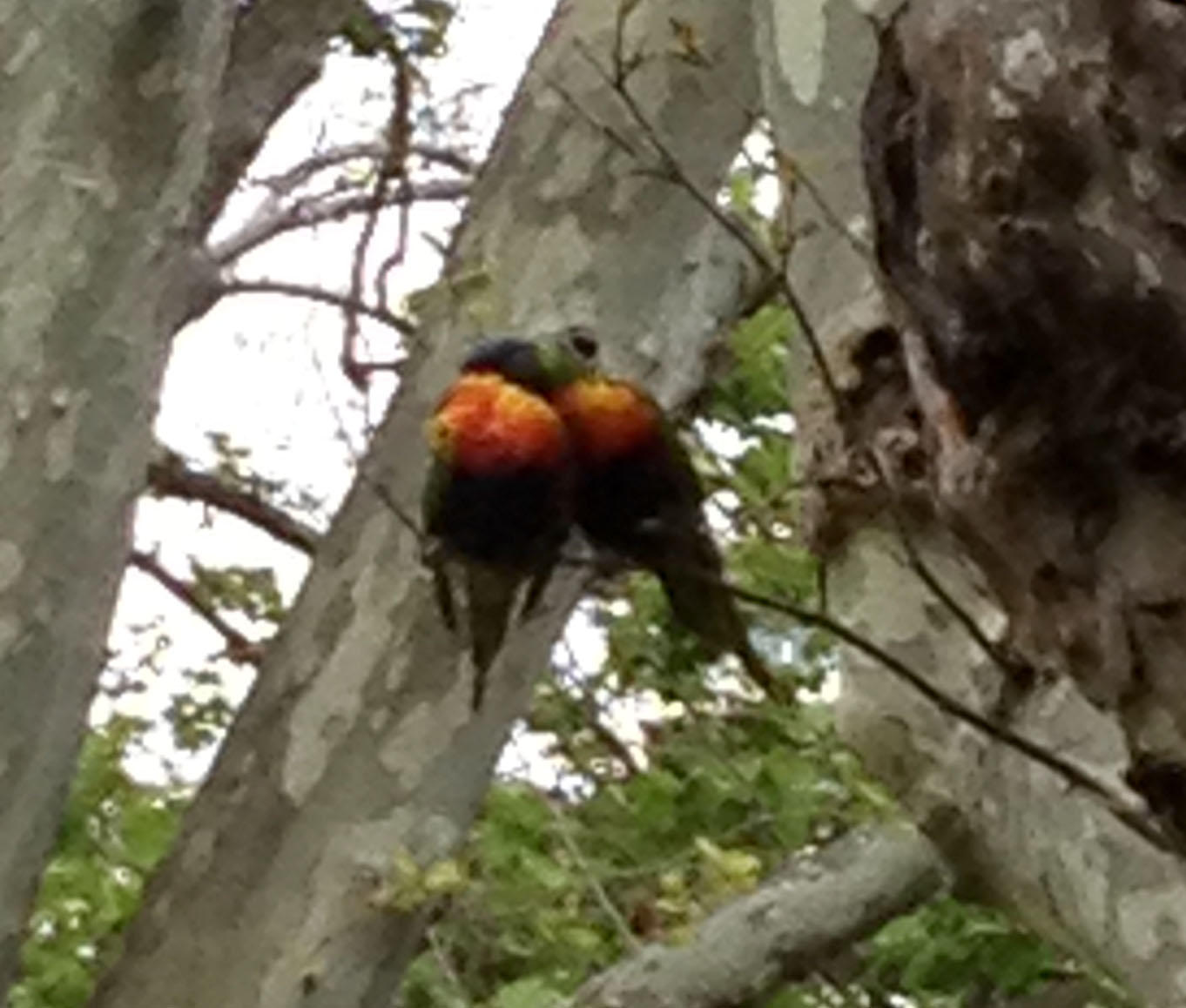
Other species found in Perth were Little Corellas, Singing Honeyeaters, New Holland Honeyeaters, White-cheeked Honeyeaters, Black-faced Cuckooshrikes, Magpie Larks, several species of ducks, and other water-dwelling birds such as grebes, ibis, herons, cormorants, darters, swamphens, moorhens, coots, and Silver Gulls.
On the 11th I hiked up (really, up) to nearby King’s Park and Botanic Garden and it was well worth the hike. The gardens are spectacular.
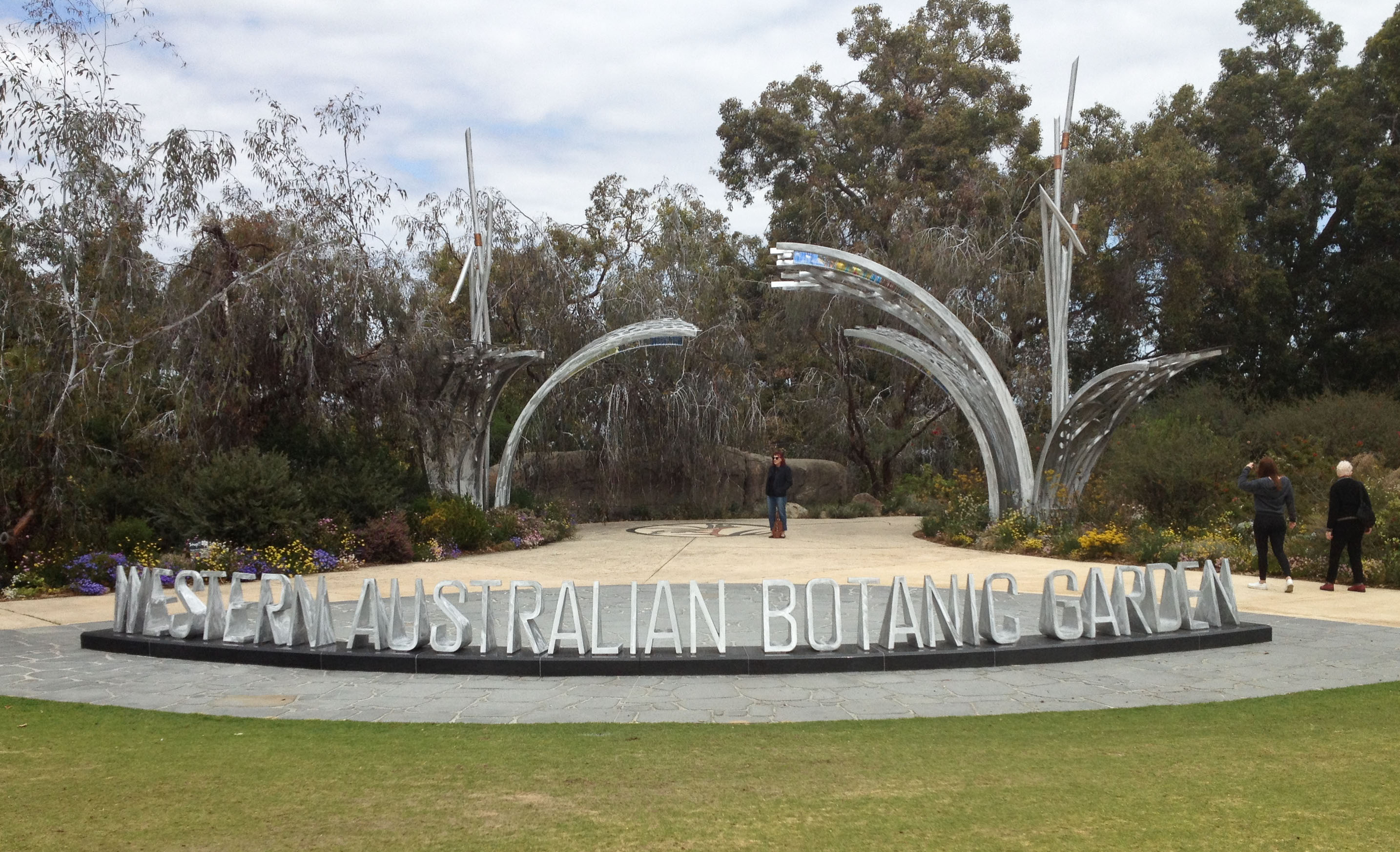
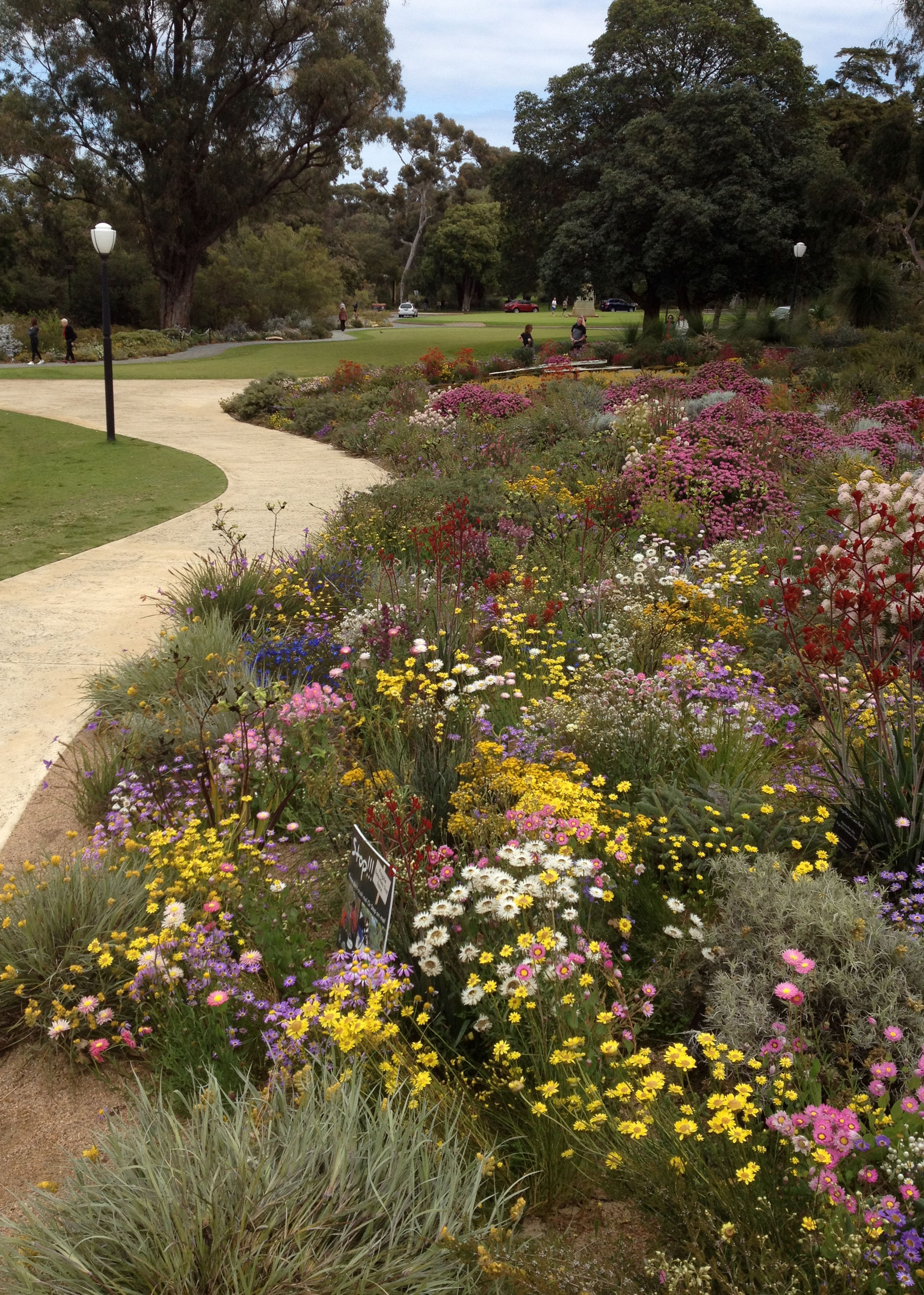
The view of Perth from Kings Park is probably the best available in the area.
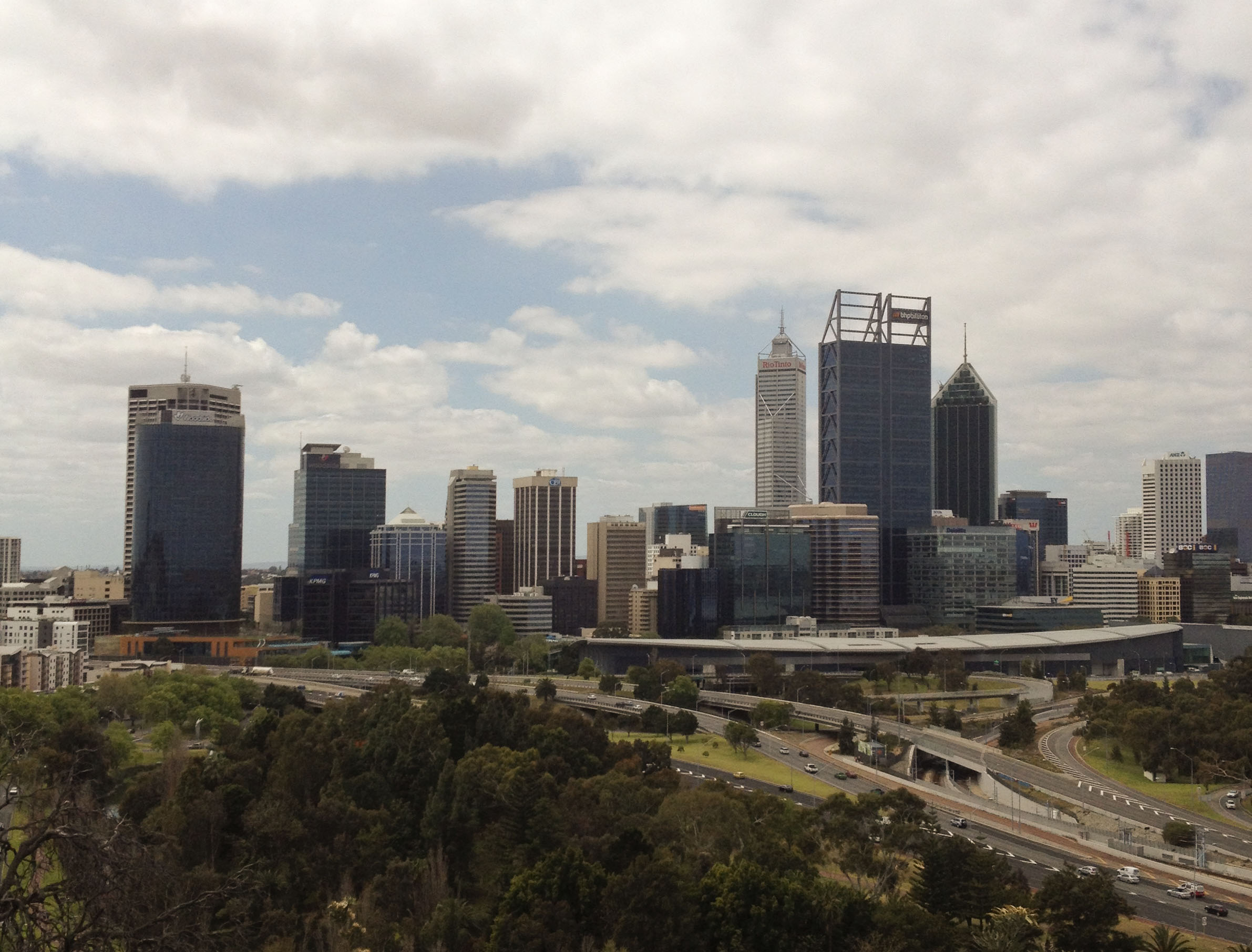
As a plus, the King’s Park restaurant serves good food. I ordered Shepard’s Pie, which was delicious and a go-to choice on my menu thereafter.
In the afternoon I hired a taxi to take me to Herdsman’s Lake, located just a few miles north of my hotel, where I hoped to find 2 of the Australian ducks (Blue-billed and Freckled) that I had never seen before, and both of which had been reported seen on Herdsman in recent weeks. My taxi driver dropped me off at “Herdsman’s Lake”, which had many ducks and people and turned out not to be Herdsman’s Lake at all. A fellow noticed me walking around distractedly looking through my binoculars at various common ducks and other water birds, and he came up and introduced himself, inquiring if I was birding. The answer was obvious, but I said yes, and that I had thought the lake would be a bit less crowded with humans and common ducks. He asked what lake I thought it was and when I said Herdsman, he laughed and said this was not Herdsman, but Herdsman was not far away and if I wished, he would drive me there. Turned out he was an Uber driver, with no fares for the afternoon. He drove me over to Herdsman’s Lake and then proceeded to join me hiking around the lake. He knew a bit about the local fauna, and together we managed to watch what he identified as a Tiger Snake (poisonous) crossing a few feet in front of us as we trod the dirt path around the lake. We spotted a fair number of Blue-billed Ducks, one of the two species I was specifically looking for. No luck on the Freckled Duck, though, which was the other, and is Australia’s rarest duck. He then drove me back to Sullivan’s Hotel and did not want to charge me anything, which I did not allow. With the spotting of the Blue-billed ducks, I now lacked only 2 duck species found in Australia for my life list: the Freckled Ducks, which were iffy, and Radjah Shelducks, which I was pretty confident of finding later on my trip in the Darwin area in Northern Territory.
At 7:00 a.m. on the 12th Peter picked me up at the hotel, and since I had pretty well exhausted the birding possibilities in Perth itself, we immediately proceeded to drive southeast about 100 miles through the beautiful south-western Australia country-side toward Dryandra Woodland. Wikipedia has a good article about Dryandra for those who care to dig deeper. On the way I spotted a small, dove-like bird along the road, which turned out to be a Painted Buttonquail. This unexpected sighting was my first of the elusive Buttonquail family. Although widely spread throughout the world, I had never seen any of the species in this family, and to see one was a reason I had selected Australia for this trip. Unfortunately, when we turned around in the road to go back for a better look, or even possibly a picture, it was gone.
The largest family group of birds in Australia is the Honeyeater family (Meliphagidae ), with about 75 species, (including honeyeaters, spinebills, miners, wattlebirds, chats, and friarbirds). The second largest family group of birds in Australia is the Parrot family (Psittacacidae ) with about 40 species (including parrots, lorikeets, rosellas, and the budgerigar). Somewhat similar to the parrots is the Cacatuidae family (cockatoos, corellas, cockatiel and galah). As we entered the dry, open woods of Dryandra, we began to see new (for me) birds of these 3 families, and others. Among the others was a flock of White-browed Babblers, one of the Australian Pseudo-babbler (Pomatostomidae) family and the second new family of the trip for me.
Among the sightings southwest of Perth were these, all photographed by Peter:
Regent Parrot
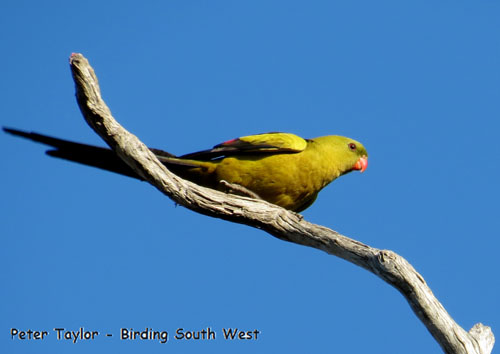
Red-tailed Black Cockatoo (Forest)
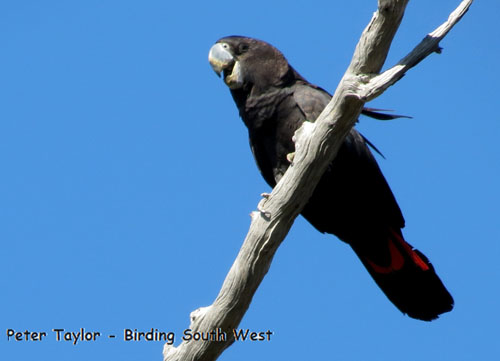
Purple-crowned Lorikeet
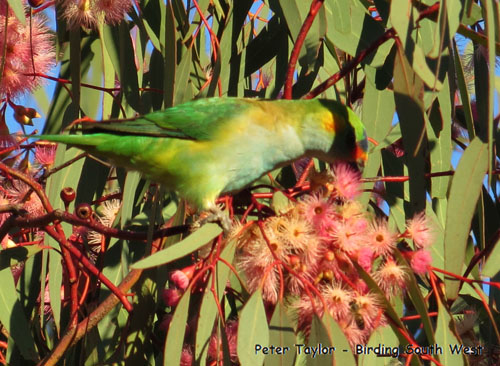
Elegant Parrot

During the course of the next 2 days, I was pleased to see most of the Western Australia endemics, i.e., birds found nowhere but in Western Australia. They included Carnaby’s Black Cockatoo, Baudin’s Black Cockatoo, Western Corella, Red-capped Parrot, Western Rosella, Red-winged Fairywren, Gilbert’s Honeyeater, Western Wattlebird, Western Spinebill, Western Thornbill, White-breasted Robin, and Red-eared Firetail.
On our first night out, we lodged near the Sterling Mountain Range. The highlight of this locale was a good look at a new species within a new family for me, a Western Crested Shrike-tit. The classification of this bird has been subject to several recent changes, but the current consensus is that it is the only species within a [new] family, Falcunculidae. Assuming this to be the case, then it was my second new family seen in Australia. There are 3 disjunct sub-species of this family, Western (the bird seen here) Eastern (seen later on the trip), and Northern (not seen). Some believe they are each a separate species, but so far that split has not been generally accepted.
There are 2 other Western Australia endemic species that I especially wished to see because they are within a family of which I had not previously seen any species. These were rare and elusive Noisy Scrub-birds and Western Bristlebirds. Both of these birds are basically brown and non-descript.
In the Cheynes Beach area on the southwest coast (by the Southern Ocean) Peter and I spent several hours hoping for a sighting of the extremely elusive Noisy Scrub-bird. The Noisy Scrub-bird is one of only two species in the Atrichornithdae Family, found only in Australia. Both species are endangered, and the Noisy Scrub-bird was thought to be extinct until rediscovered in 1961. In the thick, low-growing brush just off the beach, the ringing call of a Noisy Scrub-bird could be heard constantly. But to see it, one needed to anticipate where on a particular path through the brush it might cross. This is a small, plain, nearly flightless bird, that survives by its elusiveness. Finally, the calls seemed to come closer, and suddenly it ran quickly across the path, in less than a second. It was far from a good look, but Peter assured me it was as good as it gets, so Western Australia provided (this fleeting glimpse of) the third new Family of the trip to add to my life list.
From the beach area, we hiked, up-hill on a soft and mushy sand track, into the surrounding hilly, heath covered area in search of the second target bird, the Western Bristlebird. As the sun was setting, I struggled farther and farther along, listening for the Bristlebird, until I finally gave in and told Peter I needed to start back or I might not make it. So we came back to our lodging for the night, empty handed.
The next morning we rose early and birded with good success around the campground. After finding most of the possible new species for that particular habitat, Peter asked if I would be up to another attempt to find the Bristlebird, and hopefully, another sand-dune rarity that we had heard but not seen the night before, Western Whipbird. I agreed and within minutes we had a quick view of the Bristlebird, as it scurried across the path ahead of us giving me another new (Dasyornithidae) Family, number 4 for the trip. We still failed to spot a Western Whipbird. (The Western Whipbird is one of 3 species in the Australian Psophodidae family, and, having seen an Eastern Whipbird while spending a little time at O-Reilly’s many years ago, it would not have been a new family for me, some consolation).
We spotted several “near” endemic species during the course of our travel through southwestern Western Australia, including Rufous Treecreepers, Blue-breasted Fairywrens, Western Whistlers, and Western Yellow Robins.
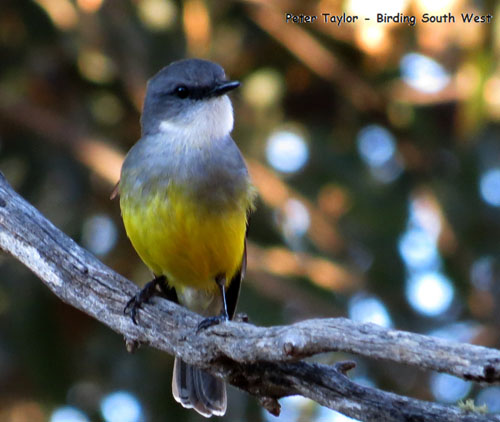
We made the long drive back to Perth, stopping along the way for looks at several new species. My days in Western Australia produced an almost even split between species that I had seen before (48) and new species (49).
Peter Taylor fit me into his busy spring-time guiding schedule, and I am grateful to him for that. He is a fine guide and a good companion. I wish to acknowledge his photographs of the parrots and yellow robin shown above, as well as of the Western Grey Kangaroo, seen during our travels.
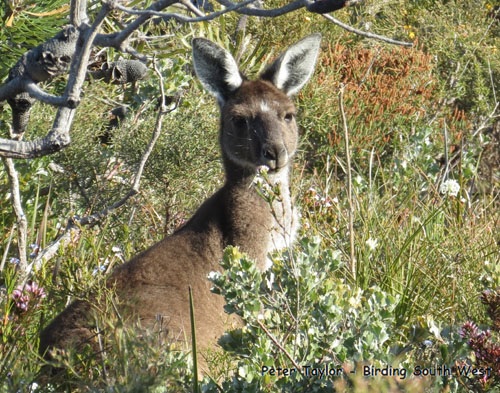
Back to Sullivan’s Hotel for the night and off at 7:00 a.m. for the long plane ride eastward to Tasmania, to be reported on in my next blog.
